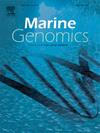从马里亚纳海沟分离出的二甲基硫代丙酸酯(DMSP)降解细菌 Sulfitobacter pontiacus WPMT18310 的完整基因组序列
IF 1.5
4区 生物学
Q4 GENETICS & HEREDITY
引用次数: 0
摘要
硫杆菌属细菌广泛分布于各种海洋环境中,在硫循环中发挥着重要作用。从马里亚纳海沟 10,890 米深处采集的水样中分离出了庞氏硫杆菌 WPMT18310。在这项研究中,我们报告了庞氏硫杆菌 WPMT18310 的完整基因组,其中包含 3533 个基因,总长度为 3706453 碱基对,由一条染色体组成。此外,该基因组还包含四个质粒,这表明它具有很强的基因转移能力。庞蒂亚克氏菌 WPMT18310 能够合成信号分子和降解二甲基硫代丙酸酯(DMSP)。降解产物二甲基硫醚(DMS)是一种潜在的信号分子,可诱导海洋无脊椎动物定居。庞氏无脊椎动物的基因组信息可为阐明硫循环的生态意义和评估其对海洋无脊椎动物定居的影响提供宝贵的见解。本文章由计算机程序翻译,如有差异,请以英文原文为准。
Complete genome sequence of Sulfitobacter pontiacus WPMT18310, a dimethylsulfoniopropionate (DMSP) degradation bacterium isolated from the Mariana Trench
Bacteria of the genus Sulfitobacter are widely distributed across various marine environments and play a vital role in the sulfur cycle. Sulfitobacter pontiacus WPMT18310 was isolated from water samples collected at a depth of 10,890 m in the Mariana Trench. In this study, we report the complete genome of S. pontiacus WPMT18310, which contained 3533 genes and a total length of 3,706,453 base pairs organized within a single chromosome. Additionally, the genome contains four plasmids, suggesting its significant capacity for gene transfer. S. pontiacus WPMT18310 is capable for synthesizing signaling molecules and degrading dimethylsulfoniopropionate (DMSP). The degradation product dimethyl sulfide (DMS) serves as a potential signaling molecule that can induce the settlement of marine invertebrates. This genomic information of S. pontiacus may provide valuable insights into elucidating the ecological significance of the sulfur cycle and assessing its impact on marine invertebrate settlement.
求助全文
通过发布文献求助,成功后即可免费获取论文全文。
去求助
来源期刊

Marine genomics
生物-遗传学
CiteScore
3.60
自引率
5.30%
发文量
50
审稿时长
29 days
期刊介绍:
The journal publishes papers on all functional and evolutionary aspects of genes, chromatin, chromosomes and (meta)genomes of marine (and freshwater) organisms. It deals with new genome-enabled insights into the broader framework of environmental science. Topics within the scope of this journal include:
• Population genomics and ecology
• Evolutionary and developmental genomics
• Comparative genomics
• Metagenomics
• Environmental genomics
• Systems biology
More specific topics include: geographic and phylogenomic characterization of aquatic organisms, metabolic capacities and pathways of organisms and communities, biogeochemical cycles, genomics and integrative approaches applied to microbial ecology including (meta)transcriptomics and (meta)proteomics, tracking of infectious diseases, environmental stress, global climate change and ecosystem modelling.
 求助内容:
求助内容: 应助结果提醒方式:
应助结果提醒方式:


